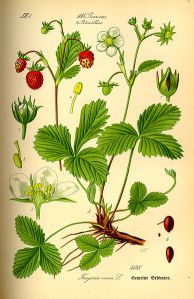 Sometimes I like to think that weeds are just plants growing where I don’t want them to be, but other times I think there is something especially pernicious about weeds that makes them different from other plants. Today I am choosing to believe the former as I weed the strawberry patch, pulling out everything that is not strawberry, including numerous flowers that I happily allow to grow in other parts of my garden—Shasta daisies, lambs ear, black-eyed Susans, coneflowers, asters, and columbine. But that creates a dilemma when I get to the edge of the strawberry patch. At what point do the strawberries themselves become weeds as they send runners out into other parts of the garden and cross over into the sections claimed by columbine or iris?
Sometimes I like to think that weeds are just plants growing where I don’t want them to be, but other times I think there is something especially pernicious about weeds that makes them different from other plants. Today I am choosing to believe the former as I weed the strawberry patch, pulling out everything that is not strawberry, including numerous flowers that I happily allow to grow in other parts of my garden—Shasta daisies, lambs ear, black-eyed Susans, coneflowers, asters, and columbine. But that creates a dilemma when I get to the edge of the strawberry patch. At what point do the strawberries themselves become weeds as they send runners out into other parts of the garden and cross over into the sections claimed by columbine or iris?
I wish I had kept better records last year when I first planted the strawberries (by which I mean I wish I had kept any records at all). I can no longer remember how many or what kind I planted. As I was weeding the patch, I ran across a couple of plastic markers, which I hoped would clue me in, but one said “curly parsley” and the other said “lavender.” At the very least, it would be nice to know whether I planted June-bearing or everbearing plants.
My gardening encyclopedia tells me that strawberries are grown to some extent in every state in the Union but that different varieties are suited to different parts of the country. A guide published by University of Missouri extension says that “no fruit is more likely to provide home gardeners with success and satisfaction than strawberries” and lists ten popular varieties that are well adapted to our state. Of these I recognize the names Surecrop and Allstar, so perhaps I planted one of those varieties. The guide also lists several everbearing and day-neutral varieties commonly grown in Missouri; of these, the name Ozark Beauty sounds familiar, although the guide says it is not truly everbearing, as it will produce a crop in the spring and a small crop in the fall, with little or no crop in between. Maybe that’s what I planted.
If the berries are Surecrop, they will, according to the guide, be large, light-colored, and tart, and will ripen in early midseason; if Allstars, they will be large, glossy, orange-red, and firm, and will ripen in late midseason. Ozark Beauties will produce medium-sized, light-colored berries of average quality. Surecrop is described as one of the most “productive, vigorous and disease-resistant cultivars”; Allstar is supposedly “resistant to red stele and verticillium wilt and tolerant of leaf diseases.” Ozark Beauties are described as “extremely variable in its performance in Missouri.”
The brochure then goes on to describe the problems facing strawberries, including various kinds of root rot, leaf spots, wilt, and mold; insects, including tarnished plant bugs, leafrollers, mites, weevils, slugs, and nematodes; as well as frost injury, nutrient deficiences, inadequate pollination, and abnormally high temperatures. If the plants somehow manage to fruit despite all this, the birds may eat them all. With so much going against them, I wonder how they can possibly provide “success and satisfaction” for the home gardener. I am glad I didn’t read about these problems last year, or I might not have planted strawberries at all.
Regardless of what variety I planted, I was apparently supposed to remove the blossoms the first year and train the runners, and I should have mulched the plants in late November or early December. As I recall, we allowed the berries to develop and happily ate a few on top of our ice cream, and we allowed the runners to take off in all directions away from the mother plants, absolutely untrained. We’ll see what happens this year.
